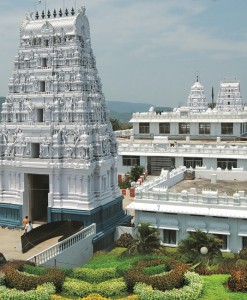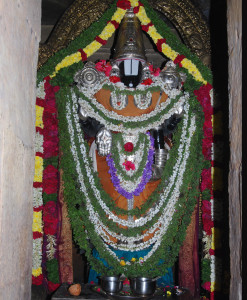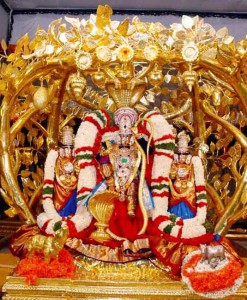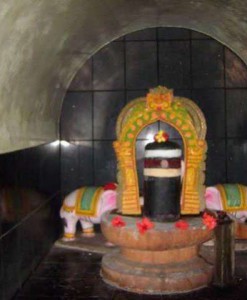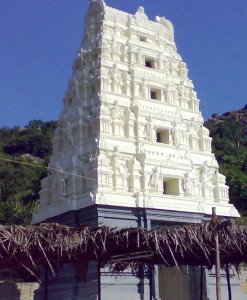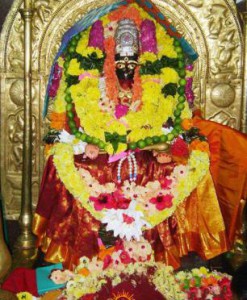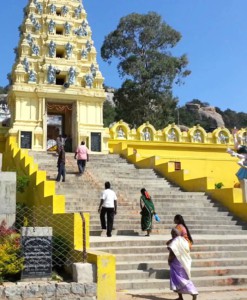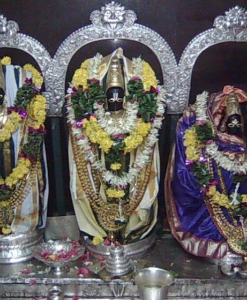Sri Venkateswara Swamy Temple, Tirumala
Sri Venkateswara Swamy Temple is a landmark Vaishnavite temple situated in the hill town of Tirumala at Tirupati in Chittoor district of Andhra Pradesh, India. The Temple is dedicated to Lord Venkateswara, an incarnation of Vishnu, who is believed to have appeared here to save mankind from trials and troubles of Kali Yuga. Hence the place has also got the name Kaliyuga Vaikuntham and Lord here is referred to as Kaliyuga Prathyaksha Daivam. The temple is also known by other names like Tirumala Temple, Tirupati Temple, Tirupati Balaji Temple. Venkateswara is known by many other names: Balaji, Govinda, and Srinivasa.
The exact period in which the temple was founded is not known. and tradition has it that the temple is Swayambhustala, meaning that it came into existence on its own without anyone constructing it. According to folk legends. there was a huge anthill at Tirupati. A farmer heard a voice from the heavens asking him to feed the ants. By chance the local king heard the voice and began supplying milk for the ants himself His compassion resulted in the liquid uncovering a magnificent idol of Lord Venkateshwara hidden beneath the anthill.
According to some evidence the history of the temple dates back almost 2.000 years. In ancient times, a queen called Samavai, belonging to the Pallava dynasty (614 AD) is said to have consecrated the first silver image here. The temple is also mentioned in Sangam poetry (500 BC – 2000 AD). Numerous temple inscriptions from the 9th century record details of the temple and contributions made by both Pallavas and Chola Kings. It is believed that originally there was only one shrine at Tirumala. ‘Alien the Vaishnavite saint Ramanuja visited Andhra in the 12th century. the temple at Tirupathi was built. The Chola period saw the temple complex prosper and expand further. In 1517. Krishnadevaraya on one of his many visits to the temple. donated gold and jewels enabling the Vimana (inner shrine) roofing to be gilded.
The Maratha general Raghoji Bhonsle visited the temple and set up a permanent administration for the conduct of worship in the temple. Among the later rulers who endowed large benefactions were the rulers of Mysore and Gadwal. In 1843. with the coming of the East India Company. the administration of the Venkateshwara temple and a number of shrines was entrusted to Seva Dossji of the Hathiramji Mutt at Tirumala as Vicaranakarta for nearly a century until 1933 when the temple was under the administrative charge of the mahants. The Madras legislature passed a special act in 1933 whereby the Tirumala Tirupati Devasthanam ITTD) committee was invested with powers of administration and control through a commissioner appointed by the Government of Madras. A Ryot Advisory Council was formed for the management of the estates of the TTD. and was assisted by a Religious Advisory Council with regard to religious matters.
Atli Sankaracharya came to Tirumala and placed Sri Chakra at the lotus feet of Lord Venkateshwara and sung the famous song -Bhaja Govindam-. According to various verses from the Puranas and other text: is the supreme God or Vishnu. Narayana or Brahman of this Kali Yuga. Lord Venkateshwara has His holy abode in the Venkatam hills the hills are more often referred to as ThiruVenkatam) near Tirupathi. Thus the main temple of Lord Venkateshwara is the Tirumala Venkateshwara Temple. The Tirumala temple. where He is the presiding deity. is believed to be the richest of all the temples in the world. The temple is in southern India Andhra Pradesh in Chittoor district. The presence of seven hills influenced alternate names for the deity: Edukondalavadu in Telugu and as Ezhumalaiyan in Tamil both of which mean – Lord of the Seven Hills.
He is also known as Maal, ThiruMaal, Manivannan, Balaji (though this is a more recent name), Srinivasa. Venkatesha, Venkatanatha, Thiruvengadam Udaiiyaan, Tiruvengadattaan and by many other names. He is also worshiped with the name Tirupati Thimmappa all over Karnataka by traditionally Shiva-worshipping communities. In Hinduism also spelled as Venkateshwer or Venkatachalapathii is a much-worshipped form of Vishnu. He is also known as Balaji or Lord Venkateshwara. He is also worshiped with the name Tirupati Thimmappa all over Karnataka by traditionally Shiva worshipping communities. Venkateshwara is the presiding deity at the Tirumala temple complex, believed to be the richest of all the Hindu shrines in the world.
Venkateswara Swamy temple is situated in southern Andhra Pradesh in Chittoor district. It is around 120 km away from Chennai. The presence of seven hills influenced alternate names for the deity: Edukondalavadu in Telugu and as Ezhumalaiyan in Tamil both of which mean Lord of the Seven Hills. In iconographic depictions. Lord Venkateswara’s eyes are covered because it is said that his gaze is so intense that it would scorch the universe
Dwarams and Prakarams
There are three Dwarams(entrances) which lead to Garbhagriha from outside. Mahadwaram also known as padikavali is the first entrance which is provided through Mahaprakaram (outer compound wall). A 50 feet, five storied Gopuram, Temple tower is constructed over this Mahadwaram with seven Kalasams at its apex. Vendivakili (Silver Entrance) also known as Nadimipadikavali is the second entrance and is provided through Sampangi Prakaram (Inner compound wall). A three storied Gopuram is constructed over Vendivakili with seven Kalasams at its apex. Bangaruvakili (Golden Entrance) is the third entrance which will lead into Garbhagriha. There are two tall copper images of the Dvarapalakas Jaya-Vijaya on either side of this door. The thick wooden door is covered with gold gilt plates depicting the Dasavathaaram of Vishnu.
Pradakshinams
Circumambulation around Sanctum sanctorum in the temple or deities is called Pradakshinam. There are two circumbulation paths in the temple. The first one is area between Mahaprakaram and sampangiprakaram. This path known as Sampangipradakshinam has many Mandapas, Dwajasthambam, Balipeetam, Kshetrapalika sila, prasadam distribution area etc. The Vimanapradakhinam is the second pradakshinam, which circumbulates Ananda Nilayam Vimanam. This path has sub-shrines dedicted to Varadaraja and Yoga Narasimha, Potu(main kitchen), Bangaru Bavi(golden well), Ankurarpana Mandapam, Yagasala, Nanala (coins and Notla (Paper notes) Parkamani, Almyrah of Sandal paste (Chandanapu ara), cell of records, Sannidhi Bhashyakarulu, Lords’s hundi and the seat of Vishvaksena.
Anandanilayam vimanam and Garbhagriha
Garbhagriha is the Sanctum sanctorum where the presiding deity Lord Venkateswara will be residing along with other small idols. Golden Entrnace leads to Garbhagriha. There are two more doors in between Bangaruvakili and Garbhagriha. The deity will be in a standing posture with four hands one in varada posture, one placed over thigh and other two holding Shanka and Sudarshana Chakra.The idol is decorated with precious ornaments. The idol bears Goddess Lakshmi on the right chest and Goddess Padmavathi on the left. Pilgrims are not allowed to enter the Garbhagriha (beyond Kulasekharapadi path)
Ananda Nilayam Vimanam is the main Gopuram constructed over ‘Garbhagriha. This is a three storied gopuram and has single Kalasam at its apex. It was covered with gilt copper plates and covered with a golden vase. There are many idols of gods carved over this gopuram. On this gopuram, there is a idol of Venkateswara known as “Vimana Venkateswara” which is believed to be exact replica of deity inside Garbhagriha.
By Road: Tirumala has direct bus services from Tirupati with a frequency of a bus in every 2 minutes. It also has direct buses from Chennai, Bengaluru and Vellore. Paid taxis and private bus operators also ply buses from nearby cities such as Chennai, Hyderabad, Visakapatnam and Bangalore to Tirupati.
Buses and other transport are banned on ghat road from Tirupati to Tirumala between 12 AM and 3 AM.
By Rail: Tirumala does not have its own railway station. The nearest railway station is in Tirupati, which is about 26 km from Tirumala. Tirupati railway station is a major railway station and is well equipped with five platforms and an escalator. It is well connected to major cities across India.
By Air: The nearest airport to Tirumala is near Renigunta about 15 km from Tirupati. This domestic airport has direct flights to Hyderabad, Visakapatnam, Chennai, New Delhi and Bangalore and is now being upgraded to an International airport.
On Foot: Many devotees climb the hills to Tirumala on foot to fulfil a vow. There are two well-laid stone footpaths leading to Tirumala. These paths are called sopanamargas. The most ancient of the two sopanamargas starts from Alipiri at the foot of the hills. This footpath is 11 km in length and is the commonly used route. The other sopanamarga (Srivari mettu) starts from Chandragiri and is only about 6 km in length.
TTD provides and maintains rest houses, security, canteen, toilets, drinking water, medical help, piped devotional music throughout the footpaths. TTD also provides luggage transfer facility, free of cost for the devotees opting to climb the hills on foot to Tirumala.
Sri Venkateswara Swamy Temple, Tirumala
Venkateswara Swamy temple Tirumala Opening & Closing times are 3.00 AM and 10.00 PM. During this period major part of the Lord Venkateswara rituals are performed. Archana, Aarti and Abhisekham are the daily pujas performed.The best time to visit this beautiful temple is in the evening during evening Aarti.
Daily Rituals
The daily sevas in Temple(in order of occurrence) include Suprabhata Seva, Thomala Seva, Archana, Kalyanotsavam, Dolotsavam (Unjal Seva), Arjita Brahmotsavam, Arjita Vasantotsavam, Sahasra Dipalankarana Seva, Ekanta Seva
Weekly Rituals
Weekly sevas of the Temple include Vishesha Pooja on Monday, Ashtadala Pada Padmaradhana on Tuesday, Sahasra Kalasabhishekam on Wednesday, Tiruppavada Seva on Thursday, Abhishekam and Nijapada Darshanam on Friday. There are no weekly sevas on Saturday and Sunday.
Periodical Rituals
Periodical rituals include Jyesthabhishekam, Aaniwara Asthanam, Pavithrotsavam, Koil Alwar Tirumanjanam.



